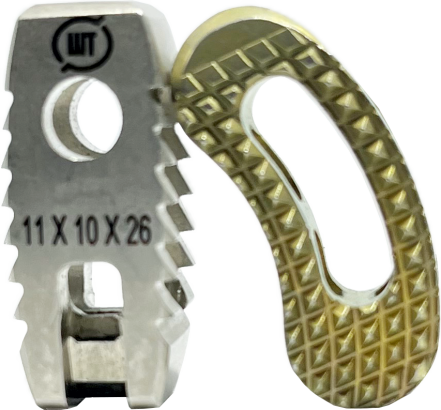Rig® (Lumbar Interbody Cages)
The Rig® implant is a device for interbody fusion of the anterior column of the spine. Rig® may be used to replace the disc. These cages are hollow so that bone can grow through the device, fusing the adjacent bony surfaces. The Rig® implant is a hollow device with texture on two opposing convex sides, and is offered in various lengths, widths and heights. W T Medical and Research Spine designed the Rig® device to be placed through a posterior or transforaminal approach and to address vertebrae in the lumbosacral region of the spine. The system contains implants of various sizes to accommodate different patient anatomy, and instruments for site preparation, trialing, insertion and extraction. The Rig® instrumentation system is comprised of instruments and perforated instrument cases that are generally comprised of aluminum, stainless steel, and/or polymeric materials.
Features
![]() Convex design
Convex design
![]() Double-bulleted design
Double-bulleted design
![]() Comprehensive range
Comprehensive range
When to use?
Indication
The Rig® Spacer is indicated for use with autogenous bone graft as an intervertebral body fusion device at one or two contiguous levels in the lumbosacral region (L2-S1) in the treatment of degenerative disc disease (DDD) with up to Grade 1 spondylolisthesis or retrolisthesis at the involved level(s).
DDD is defined as discogenic back pain with degeneration of the disc confirmed by history and radiographic studies.
Patients with previous non-fusion spinal surgery at involved level may be treated with the device.
Patients should be skeletally mature and have had six months of non-operative treatment.
The Rig® Spacer is implanted using a posterior or transforaminal approach and is intended to be used singly or in pairs with supplemental fixation
CONTRAINDICATIONS MAY BE ABSOLUTE OR RELATIVE. CIRCUMSTANCES BELOW MAY REDUCE THE CHANCES OF A SUCCESSFUL OUTCOME:
Contra-Indications
Disease conditions which have been shown to be safely and predictably managed without the use of internal fixation devices are relative contraindications to the use of these devices.
Active systemic infection or infection localized to the site of the proposed implantation is contraindications to implantation.
Severe osteoporosis is a relative contraindication because it may prevent adequate fixation of spinal anchors and thus preclude the use of this or any other posterior spinal instrumentation system.
Any entity or condition that totally precludes the possibility of fusion, i.e. cancer, kidney dialysis or osteopenia, is a relative contraindication. Other relative contraindications include obesity, pregnancy, certain degenerative disease, and foreign body sensitivity. In addition, the patient’s occupation or activity level or mental capacity may be relative contraindications to this surgery. Specifically, some patients may, because of their occupation or lifestyle, or because of conditions such as mental illness, alcoholism or drug abuse, place undue stresses on the implant.
Known patient sensitivity to device materials
Prior fusion at the level(s) to be treated.
Any condition not described in the indications for use.





